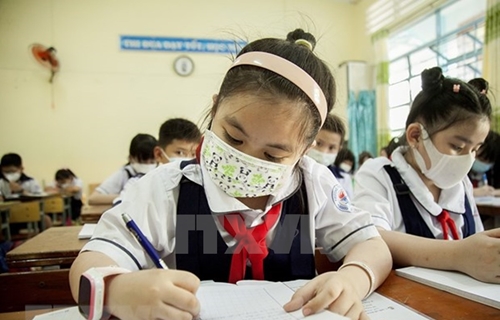The COVID-19 crisis has forced school closures for months, disrupting the learning process of millions of Vietnamese students.
“Prolonged school closures contribute to adverse social, educational, health, and economic impacts for children and society,” Park told the Vietnam News Agency. He particularly pointed out that one of the most vulnerable are disadvantaged children who are inequitably affected because of the challenges in accessing remote learning.
    |
 |
|
Vietnam is pushing for the plan to reopen all schools in the nation this month after a long closure because of the COVID-19 pandemic. |
“While some transmissions have occurred in schools, schools do not pose a higher risk of COVID-19 transmission than other settings such as workplaces, restaurants, and shopping malls,” he said.
WHO acknowledges that the Government of Vietnam has been assessing the reopening of schools, with careful consideration of the country’s outbreak situation, latest available evidence based on experiences of other countries and the concerns of some of the parents on children’s safety, the official said.
“We could not eliminate the risk of COVID-19 transmission in schools, but we can reduce such risk through appropriate infection prevention and control measures,” he noted.
The WHO representative underscored that vaccination of children should not be considered as a pre-requisite condition for school opening. A safe learning environment can be created for children through the consistent implementation of 5K measures at school as well as in the community.
According to Park, to do so, Vietnam can also implement a mechanism for early detection and response to outbreaks in schools, including rapid communication to parents, teachers, and other key stakeholders; and ensure the adoption of public health measures including infection prevention and control, consistent mask-wearing, adequate and ventilated spaces for learning, physical distancing, attention to high-risk behavior and options for hybrid learning.
It is also critical to sustain persistent risk communication both within school premises and through mass media, he stated.
He went on to highly speak of how Vietnam has ramped up its vaccination campaign since June 2021 to reach a high vaccination coverage.
As of February 13, a total of 186 million doses of vaccines had been administered in the country. About 75 million people, or 76 percent of the total population, have already completed the primary series of COVID-19 vaccination, according to WHO.
It means that Vietnam has already reached the goal set by WHO that by mid-2022, all countries in the world should have vaccinated at least 70 percent of their population, he claimed.
Data from the Ministry of Health shows that up to 95.4 percent of Vietnamese children aged 12-17 had received at least one dose of COVID-19 vaccines and 89.7 percent doubled vaccinated as of last weekend.
The country is planning to start vaccine rollout for children aged 5-11 within the first quarter of this year. However, a number of Vietnamese parents remain hesitant about vaccinating their kids.
“We understand that some Vietnamese parents are concerned about the safety of COVID-19 vaccines,” Park said. “Whether or not there is a need to vaccinate children.”
COVID-19 vaccines which have received authorization by stringent regulatory authorities for use among children are safe and effective in preventing severe disease developments, hospitalizations and deaths due to COVID-19, and to some extent, in reducing transmission of the disease, he explained.
“Children and adolescents tend to experience a milder COVID-19 disease compared to adults, though there are other risks that we need to consider when a child gets sick with COVID-19 such as multisystem inflammatory syndrome in children (MIS-C), a serious condition that can prolong a child’s recovery from COVID-19.”
To ensure the safe rollout of vaccines to children aged 5-11, the official recommended the Vietnamese Government to develop a well-planned system for acquiring and distributing the vaccines as well as a robust system for monitoring, reporting and response to safety and adverse events following immunization.
The government should also implement communication strategies for the wide dissemination of messages on the safety and effectiveness of vaccines, possible side effects, and the benefits of getting vaccinated, he noted.
Source: VNA